Summer water supply with a pumping station. We choose a pump for the well. Principle of operation of surface pump.
Each summer resident, especially accustomed to comfort, realizes the importance of running water in a house outside the city. It is hard to imagine without it a decent care of the territory near the estate, and the use of household appliances becomes impossible. To build a waterpipe on a summer residence by the hands under force to each owner of a country manor!
How is an autonomous water pipe
The installation of a water supply system is ideally considered in the process create a project at home . At this stage, a clear action plan is drawn up, a scheme of the pipeline and mechanisms is drawn. Preliminary estimates must be calculated, a purchase made necessary material and equipment. It is best that a separate, small-sized premise on the first floor of the house with an area of 2-3 m 2 be allocated for the installation of the boiler-water unit. If you install the input node and technical devices in this way, during operation it will be convenient for you to regulate the water supply and, if necessary, to repair the system.
![]()
So, the water supply system consists of such links:
- Pipeline complete with stop valves and fittings. The pipes used here need not necessarily be metal, they can be polypropylene or metal plastic.
- Mechanisms for water supply - submersible pump or a pumping station.
- Devices for regulating the pressure in the system. It can be a relay, a pressure gauge and an expansion tank.
- Automated electrical support.
List of tools
To install a water pipe of any complexity, you will need tools such as:
- A set of keys: gas # 2, drawbar and nut - # 17, 19, 22 and 24.
- Pipe cutter.
- Pencil, knife and tape measure.
- Grinding paper.
- If you selected polypropylene pipes , then you should purchase an electric soldering iron.
- If the pipes are metal, then a specially designed saw is needed.
- Hacksaw.
- Scrap and shovel.
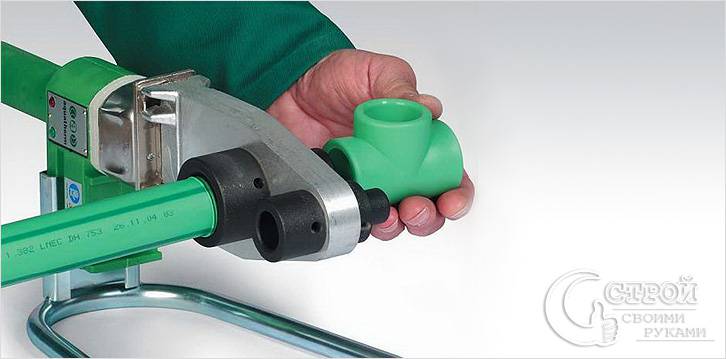
Before you start digging a trench, you should mark the water line on the plot. To do this, perform all measurements using pegs, twine and measuring tape.
Note! A thoughtful approach to work will help you save not only costs, but also precious time, so carefully calculate the number of pipes, cranes, corners, valves, fittings and other important elements.
Summer water supply
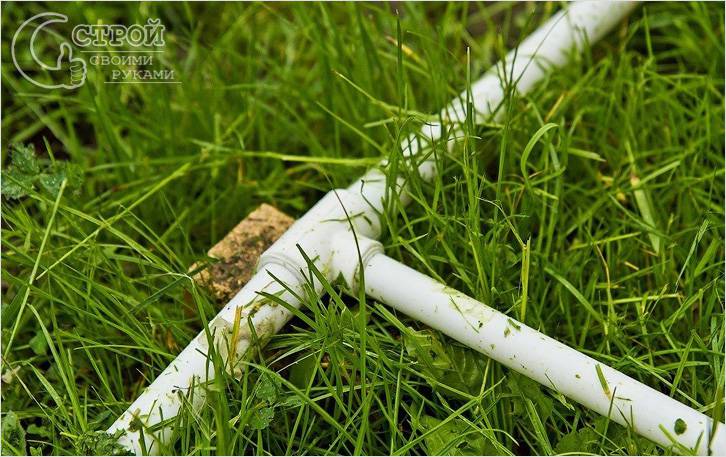
Summer water supply system is called a water supply system, which can be used only in the warm season. It is usually used to irrigate plantings, connect year-old soul and household needs. The operation of such a system in the winter cold is impossible. Summer water supply can be either demountable or permanent.
The simplest method of installation is to hold the hoses straight on the ground. To do this, use silicone or rubber pipes, which are connected with each other by adapters. They are sold in all construction stores. Adapters made of galvanized steel have better characteristics, but they are more expensive, so many prefer their plastic counterparts. In addition, special snaps can be used as a hose connector. On one side there are some "ruffs", on which they put on the hose, and with the opposite side There is a spring-loaded connector. In one movement, you can either connect or detach the latch. The joint is very reliable. If you are interested in purchasing a durable material, then pay attention to the thick-walled rubber hose, because it is reinforced with nylon fibers. Its service life is at least 15 years.
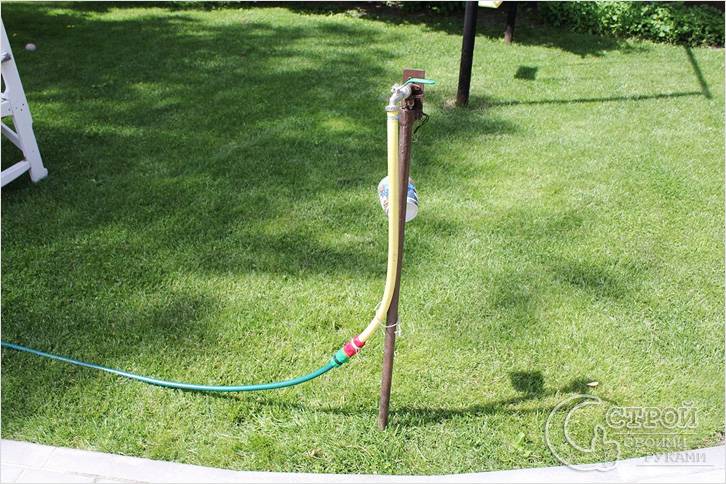
If you prefer to create a permanent system summer water supply, then the pipes should be laid in the ground, and the water tap should be brought to the surface. The depth of the trench should not be large. The pipeline is covered with earth in order not to stumble on the pipes and hide them for a period of absence of the owners of the dacha.
Note! During the installation of the system, you will have to lay all the pipes under the slope, which should be directed towards the connection to the highway. This will be the lowest point water supply system. Here you should screw the drain valve, with it you can drain the water from the system for the winter period. Otherwise, the water will freeze the pipes after freezing, even if they are plastic!
Winter water supply
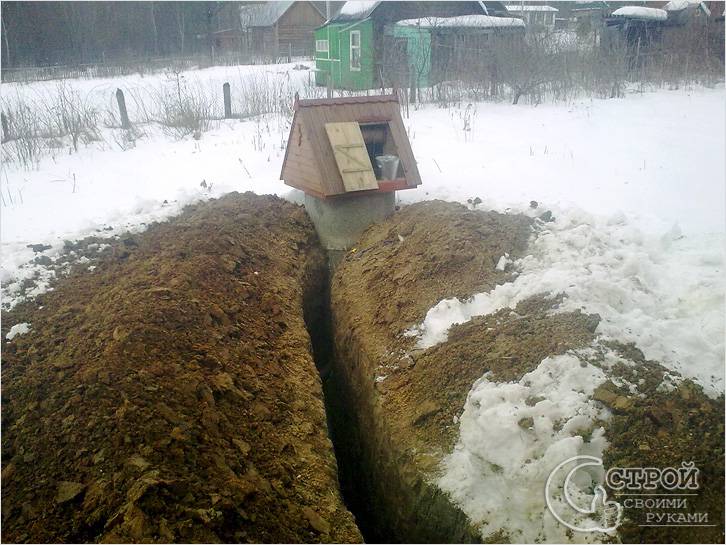
The capital system of winter water supply can be used all year round, regardless of whether it is cold outside or not. If your garden has well , then the plumbing can be done without difficulty. For this purpose you will need submersible pump. The choice of capacity of the device depends largely on the depth of the well, from which the water supply will be organized. The technical characteristics of the unit can be found in the relevant documentation or by talking to a specialist.
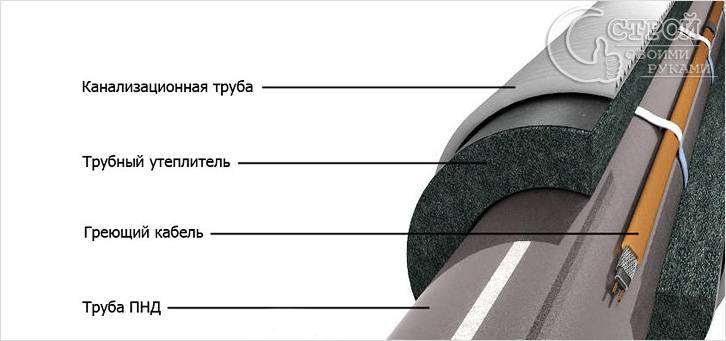
A submersible pump is always connected to electricity. All electric wires can be stacked in one casing with water pipes. So, you can prevent mechanical damage to communications and protect them from the effects of cold. Quality installation of the water supply system implies compliance with all the above technical conditions and norms. Pipeline should be laid below the freezing level of the earth. Dig a trench about 60-100 cm deep. The water pipe itself will have to be covered with a heater, its thickness should be about 30 cm. This can be foam foam, expanded clay and other suitable insulation material. The main thing is that it is moisture resistant and durable.
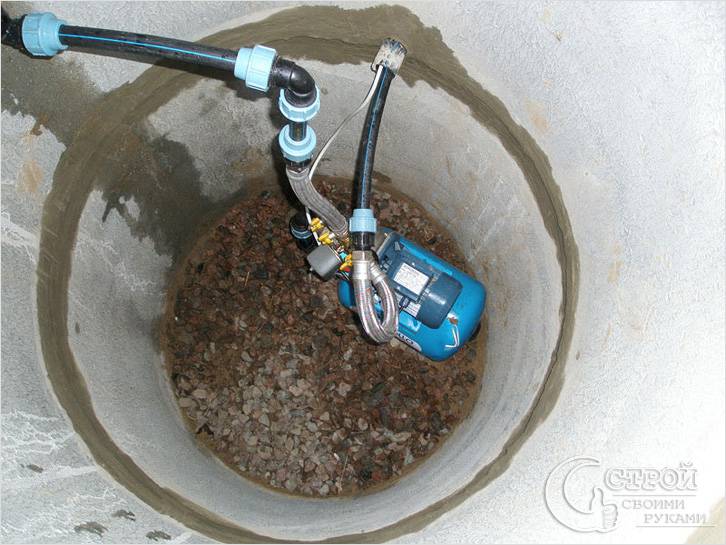
Near the well, build a pit, about 70x70 cm in size and about 1 m deep. It is needed to connect the pump. Walls should be laid out with boards, concrete rings or bricks. If you prefer boards, please note that they must be treated with antiseptic preparations beforehand. The bottom can be filled with concrete or simply covered with a layer of gravel. In the ready pit, a pipe with a special hose anchorage, which extends from the pump, and electric wires, must be removed. So, you can disconnect and attach the unit if necessary, for example, for carrying out repair work. It is important to protect the pit from freezing, for this, heat it. To create a secure connection to electricity use hermetic contact sockets or waterproof sockets.
Note! Regardless of what type of water pipe you choose: summer or winter, make it so that, if a fault occurs, the fault can be eliminated without completely dismantling the system.
Installation of water supply system
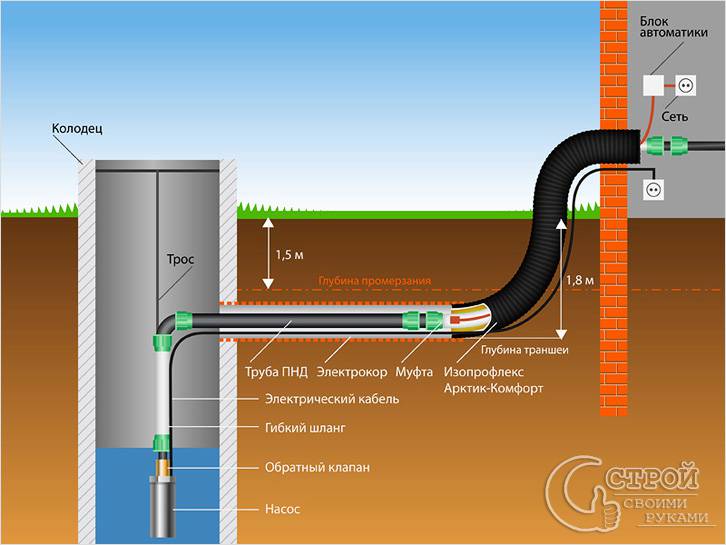
To safely mount a water pipe in the country, you should be reserved for strength and patience. Dug trenches should be carefully checked - whether the depth is correct, whether the bottom is cleaned, whether the slope is correct, etc. Now you can load a deep pump into the well or well.
Connect the device according to the instructions supplied with the machine. The pipe must approach the fitting to which the accumulator or pressure gauge is connected, a pressure switch. After connecting the mechanisms, to the last conclusion you will need to connect the main pipe and along the trench to bring it into the house. Here, and laid the armored cable, which is needed to power all equipment. It is very important that at the entrance to the building a well with stopcocks is made, which will ensure good access to the water supply system during the preventive works or repair. Now you can start installing filters, laying a water pipe directly through the house, organizing water heating and final connection.
Do you already have experience in installing a water pipe in the country? Maybe you have any difficulties in the process? What helped you cope with them? Maybe you invented an innovative method of installation? Write us comments, your experience is valuable!
A photo
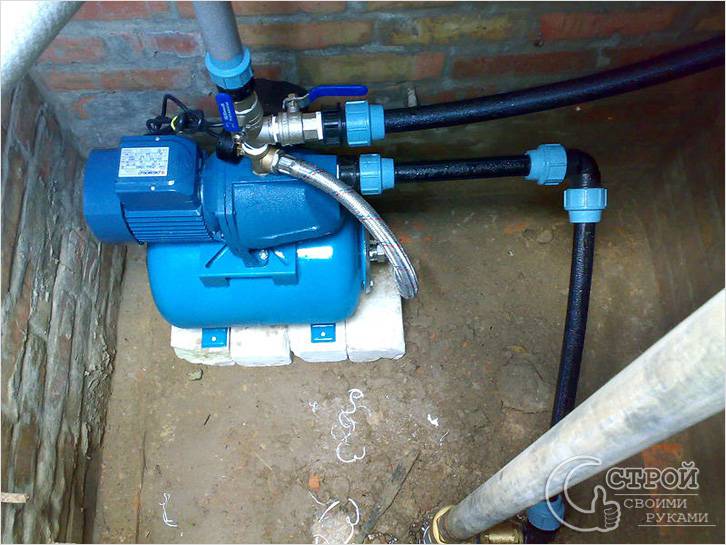

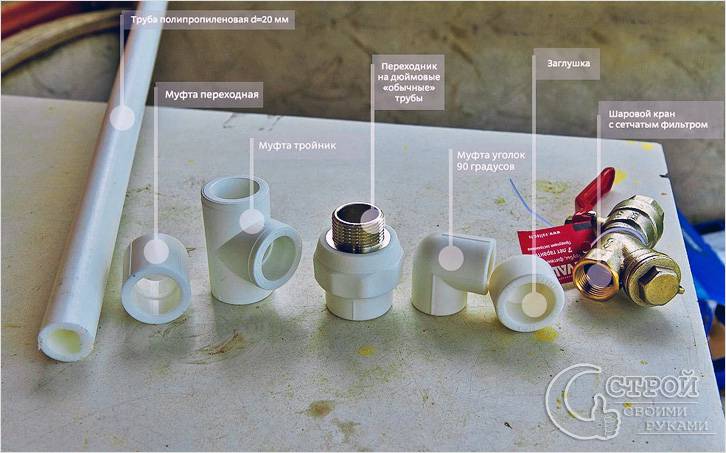 The scheme of the device of an autonomous waterpipe
The scheme of the device of an autonomous waterpipe
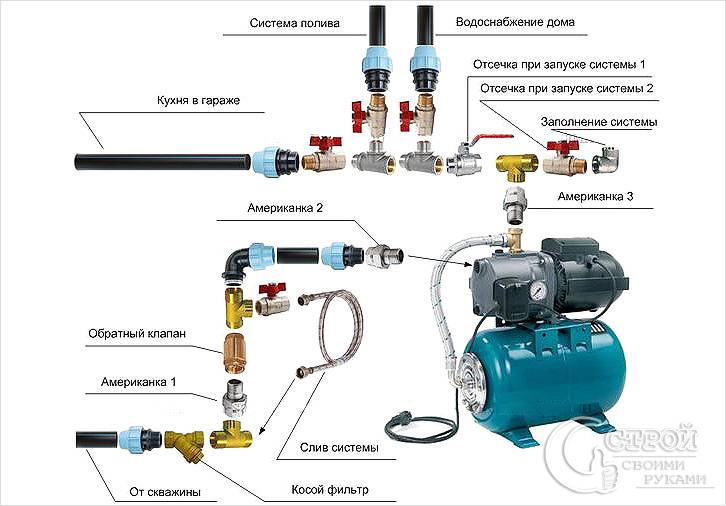
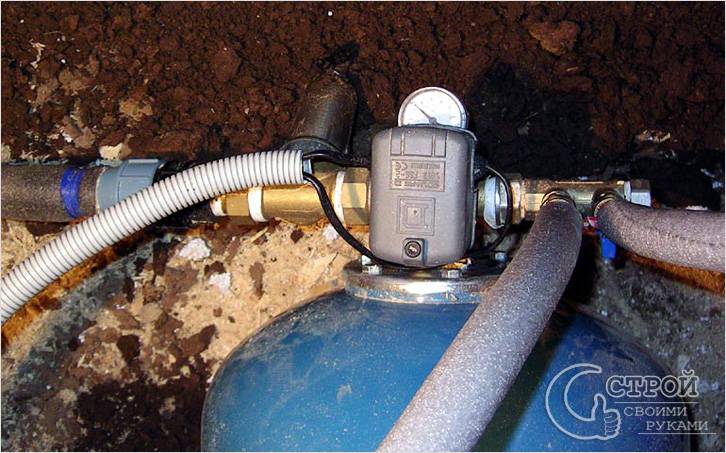
More recently, living in a private house has been associated with a number of household inconveniences. For example, there was no bathroom or shower in the house, full washing in the kitchen too, a toilet in the street, washing only by hand. Water had to be carried by buckets from the nearest well or from a well with a crane located on the street.
In the end, everything that you brought is used up. The dishes are washed in a bowl, bathed in a basin, preheating the water in a large container. All these problems are solved by a full-fledged water supply to a private house and proper water disposal. Even on the basis of an already existing well or well, it is possible to bring water directly into the house to all consumers. This will allow you to use all modern amenities of civilization, such as washing machine, dishwasher, you can take a shower or other water procedures right in the house.
What can be the private water supply system
There are several ways to arrange water supply in a private house, differing by different sources of water intake.
Centralized water supply is possible only if there is a water main near the house. To connect to it, you need to contact the organization for the control of water supply systems in your area. The organization will provide specifications connecting the house to the branch of the aqueduct. There will be indicated the place of connection, the depth of the water pipes, their diameter, as well as the water pressure (head), which is guaranteed.
In practice, the connection of a private house to a central water supply has a number of disadvantages: the water pressure may drop sharply, or be very small, insufficient for the normal operation of the water supply, the water contains chlorine and other additives. Also in the event of an accident on the line, the house will remain without water. But if the electricity goes out, the water supply will not stop. For the services of the central water supply it is necessary to pay monthly, according to the water flow meter.
The autonomous water supply of a private house can be realized by taking water from a well or a well.
What is better to equip the site, well or well, depends on the properties of the soil, the depth and location of the aquifers, as well as the productivity of the water core.
The well is mainly equipped when the quality water suitable for consumption is located at a level of 4 to 15 m deep. At the same time, the aquifer should be large enough to provide all the needs of a family of 4 people. The average supply of water is 200 liters. Due to the fact that ground water can penetrate into the well, the quality of water can be low.
An undeniable advantage of the well is that in the event of a power outage, water can be collected by a conventional bucket on the rope. Also, the life of the well is at least 50 years, which is much more than a well. The cost of equipping the well is less than a well. If you dig the shaft manually manually, then you have to pay only for the material for the walls and for the work on their installation.
Before deciding what to do on the site, a well or a well, talk to the locals, take water samples from them for analysis. Most often, if everyone digs wells in the area, it makes sense to take advantage of their experience and not reinvent the wheel. The same is true with wells.
Depending on the depth and variety of the layer from which water is taken, there are wells "on sand" and artesian wells.
The well "on sand" got its name because it affects the upper aquifers of the so-called sandy horizon, which follows a thick layer of loam filtering groundwater. The depth of such a well can reach 40 - 50 m. In different regions, the occurrence of this aquifer may be different. There are even cases when drilling such a well can get to the channel of the underground river at a depth of 15 m. In this case, the pipes and filters will not be clogged with sand, as the structure of the layer consists of pebbles. The life of such a well can reach 15 to 20 years, while a conventional well "on sand" will last 5 to 7 years. Stock of water about 500 liters. It is possible to drill such a well manually, it is much cheaper, and the excavation of soil will be less. It is more likely to get on a good aquifer, since drilling is done by experience. Machine drilling of a well is much more expensive, but less efficient, since the machine hits the well at a given depth, it is quite difficult to get to a good aquifer layer.
The artesian well descends to the aquifer in limestone rocks. The depth can reach 135 m. Undoubtedly, this water is much better than the water of the upper layers. The stock is practically unlimited, the minimum is 1500 liters. Special equipment for water intake is not needed, since water is under pressure, it shoots up itself. The probability of sewage or groundwater in the artesian well is completely excluded. The service life is the same as that of the well - up to 50 years. The cost of drilling is much higher than that of the well "on the sand" because of the greater depth. And most importantly, artesian wells must be registered, since the limestone aquifer is a strategic reserve of the state.
The scheme of water supply of a private house implies the use of a pump or a pump station for water intake. They are installed in the house, in the utility room, or immediately above the well - in the caisson and connect with the water source pipe. The pump pumps water into the accumulator. From it around the house the pipes to the consumers diverge. When someone in the house starts to spend water, for example, turned on the tap in the shower or in the kitchen, the pressure in the system gradually decreases. When it reaches 2.2 bar, the pressure switch is activated and turns on the pump, which again pumps the water into the accumulator until the pressure is 3 bar. The pressure switch is activated again and the pump is switched off.
Scheme of private water supply system
Briefly the scheme of water supply of the house consists of such elements:
- Source of water: well, borehole or river.
- Pump for water intake from the source.
- The accumulator, which is necessary to create a certain pressure in the system. With it, you can control the on and off of the pump.
- Filters for water treatment and water treatment. To properly select the equipment, you need to take water samples and do tests. Technical water, which will be used for washing the car, watering the garden or other needs, there is no need to filter. Therefore, it is diverted through a separate pipe, bypassing the cleaning systems.
- Installation of water-heating equipment for hot water supply.
- Collector system of water pipes with cold and hot water.
It is best to equip the water supply of a private house with one's own hands in the warm season, when the water level is the lowest, and the chance of making mistakes with the location of the aquifer is very small, and the soil is malleable, it is easy to dig trenches. Depending on the conditions of the intake, where the water source is located, what depth, what type, various pumps are used. The accumulator is also a rather expensive unit. So many do not install it, but use other methods of pump control performed independently.
Water supply of a private house from a well
Despite the ubiquitous fashion for wells, still in many regions they prefer to dig wells to provide themselves with water. In many respects the reason is that in case of force majeure it is possible to draw water from it with a conventional bucket.
Taking samples of water from neighboring wells for analysis and obtaining satisfactory results, you can start looking for a place for your well.
Search for the best place for a well, where there will be an abundant aquifer at a not very deep depth, can be done with the help of grandfather's methods or modern appliances. It is still trouble-free to monitor the presence and volume of dew very early in the morning (4-5 in the morning in the summer) for half a year. The collected information is summarized, and then charts are drawn up and the place where the most water is found.
In addition, a number of sanitary restrictions should be considered: at a distance of 50 m there should be no toilets, cesspools, sewerage, compost heaps or other sources of pollution. Do not also place the well too close to the house, as washing the sand out of the mantel can lead to shifts in the foundation.
Once you have found a place, you can order a private water supply project. In principle, it can be done independently, with minimal engineering skills, but it is better not to take risks. While the project is being prepared, it is possible to start digging a well.
How to dig a well
We will consider a variant of a well with reinforced concrete rings. First of all, we level the area on which we are going to make a well. Then we draw a circle with a radius of 10 - 20 cm more than the radius of the ring.
Using a shovel, we dig a round hole of the required diameter. We stop when the reinforced concrete ring installed in the pit will protrude by 10 cm. Most often the height of such a ring is 90 cm, but sometimes 100 cm.
We install the first concrete ring. To do this, carefully deliver the ring to the pit in the position on the side, then turn it over and lower it into the pit. At the end we fix a minimum of 3 connecting braces.
Then we continue to dig, again by the depth of one ring. We put the soil in a container and lift it up. We lower the first ring down and set the second in the brackets. Since we plan to build a water pipe into the house, in the second ring it is necessary to make a hole for the pipe with a diameter of 1.5 times the diameter of the pipe.
We continue to dig and install new rings until the water begins to flow intensively into the well. Approximately this should happen after 6 - 8 rings. It is desirable that water-bearing veins (fontanels) were more than 3. We stop and start pumping out the water and sand that is being washed. We continue to go deeper into the ground for another 40 - 50 cm, while the pump is pumped out, since the arrival of water is quite intense.
When excavation is completed, we leave the shaft of the well for a day filled with water, we need to know its level. We close the future well with something so that no one accidentally falls inside. In a day we look, how many in a water well. If more than 1 - 1.5 m - good. Pump all the water again.
At the bottom lay small stones, on top of the rubble layer of 30 - 50 cm. This will be our filter.
We fix all the cracks between the rings with a cement-sand mortar, so that the perch does not get into the well. If we did everything correctly, the well should fill approximately 1.5 concrete rings.
How to connect a pumping station to a well
The device of water supply in a private house involves raising water from a well using a pumping station and distributing it throughout the house.
The pump or pump station for the well is best placed in the house or utility room. Therefore, from the well to the house we dig a trench below the depth of freezing of the soil and lay a pipe in it.
The material of pipes is different - steel, metal-plastic, copper and others. Choose according to the budget and the necessary characteristics. Convenience metal-plastic pipes in that they bend. We put the pipe into the hole in the ring of the well, bend it and lower it down to the water itself. Inward we insert the mesh inlet filter.
The pipe should not reach the bottom of the well by 30-40 cm. Now we again pump out all the water from the well, drive into the bottom of the pin and attach a pipe to it. The hole in the concrete ring for the pipe is sealed with cement mortar.
Bury the trench and equip the clay lock around the well at a depth of 40 cm, 50 cm thick, at a distance of not less than 1.5 m from the rings. This is necessary to protect the well from rain and groundwater.
For the correct choice of the pumping station, it is necessary to know the characteristics of our well. The most common pumps pump water from a depth of 9 m and raise up to 40 m. But for a well at a distance it makes sense to purchase a centrifugal self-priming pump with external ejector, which can lift water from a depth of up to 45 m.
In the room where the pumping station will stand, the temperature in winter should not fall below +2 ° C. The coarse filter, as well as the non-return valve, is installed before entering the pump. Filter fine cleaning set after the pumping station. Then connect the pressure switch, pressure gauge and other devices. We divert the pipe into the collector, distributing it to consumers. The pump station is connected to the control panel.
Remains only to install a water pipe - and everything is ready.
Water supply of a private house from a well
The main advantages of the wells are: cleaner and quality water with a smaller share of perchage, more water for household needs of a large family.
The same limitations apply to the location of the well as to the well. With the exception that it can be drilled near the house.
The price of a well for water depends on the type of well, on the drilling method, and therefore it is individual for each.
How to drill a well
To drill a well manually, a tripod, a drilling column with a drill and a hoist are used.
Over the site of the future well, a tripod is installed and drilling and excavation begins.
For the first 1 - 1.5 m, a whip drill is used to remove the soil from above. Then a casing with dents is inserted into the hole and drilling is continued until a suitable aquifer is found. The first layers can be passed and drilled further. When the layer is found, inside casing inserted galvanized water pipe with a filter at the end. The pieces of the pipe are connected with each other by couplers, the joint is carefully lubricated with a sealant. Then the casing is removed.
For the well, a pit with at least 1 m depth is required. In it at 10 - 15 cm from the bottom of the "peeps" the pipe of the borehole.
How to connect a pumping station to a well
You can install the pump station in two ways. The first - right above the well to equip an auxiliary warm room, if it is near the house. The second is to install a caisson above the well in which the pump will stand.
On the first method, we will not go into detail, since with it everything is more or less simple. Consider installing the caisson.
We dig a pipe to a depth of 2.5 m, a diameter 2 times larger than the diameter of the caisson. At the bottom pour a concrete cushion 20 cm thick, which will keep the weight of the caisson on itself.
Then we set the caisson in the pit. The borehole is cut so that it protrudes 500 mm inside the caisson. At this level, approximately at a depth of 1.8 - 2 m, we dig a trench leading to the house. In it we put a water pipe.
The pump is installed in the caisson and connected to the well pipe. But the accumulator, in which the pump will pump up the water, still need to be installed somewhere in the house or utility room. There we also install filters and control unit pumping station.
Caisson on the contour fill concrete solution layer 30 - 40 cm. When the concrete dries, the rest of the space, not reaching 50 cm to the top, is filled with a mixture of sand and cement. Above ground is filled. The caisson will be well protected from frost.
Hot water supply to a private house
When water is brought directly into the house, it will not be difficult to heat it. To do this, you can use several options.
The first is to install a double-circuit boiler, for example, a gas boiler. One circuit will heat water for the heating system, the second - for domestic needs. From the pumping station the pipe with cold water It is connected to the boiler, a hot water pipe comes out of it and connects to a collector that distributes water throughout the house.
The second option is to install a single-circuit boiler that will deal with the heating of water for the needs of the house. It can be gas or electric. It is absolutely necessary to install a boiler.
The third option is to install an electric storage water heater.
The fourth is suitable for large cottages. You can install multiple flow heaters before each consumer.
Installation of water supply in a private house will be completed when a water pipe with hot and cold water is installed throughout the house. Also, one should take care of the sink, i.e. sewerage or septic tank. Wastewater is an indispensable element. Now take out the water buckets will not work. It is necessary to arrange drainage of water from the sink, shower, bath, washing machine and toilet. published
The water distribution at the dacha for irrigation can be simplified to a large extent if a central water supply is connected to the suburban area. The variant with drilling an artesian well is suitable in the case when there is no other way to bring water to the dacha. This method is more expensive, but in the future it will be possible to use the liquid without restrictions. In any case, take care of the normal water supply system suburban area it is necessary first of all.
What will it take to work
After the water is brought to the site, the pipe routing is started on the plan. This allows you to correctly distribute the need for watering in the country. If you do not have experience with such systems, you can refer to specialists. To save money, the following recommendations will help in the layout of the water supply system.
Determining with what areas of the dacha should receive water, proceed to draw the layout diagram. To do this, make a calculation of the pipe footage, select all the necessary fittings: adapters, couplings, cranes, corners, tees, etc. If the plan is prepared taking into account the scale at which all the water delivery points will be indicated, this will allow for faster orientation in the water supply system during its installation.
Plumbing will be required not only for the house, but also for all key locations in the suburban area. To them it is necessary to bring pipes, to connect hoses and to put on them cranes. Typically, sprinklers are installed to irrigate nearby beds. It is not very convenient to transfer heavy hoses, therefore several hoses are connected to the wiring at the same time. The presence of a number of water intake points will allow you to quickly cope with the watering of plants in the country.
IT IS IMPORTANT TO KNOW!
You have already tried a lot of money WITH HYPERTENSION? If you continue to "knock down" the pressure of the pills, after a while it comes back again. Hypertension is the main culprit of strokes and hypertensive crises. Find out what advises the famous cardiologist Leo Bokeria , so that your pressure is always 120/80 ...
Water distribution scheme
Making the layout of the wiring, provide a drain cock at the lowest point of the site. With the help of it, you can drain the water before the frost, because frost and cold lead to freezing of water in the pipes. This can destroy the system, since the density of the liquid that has turned into ice will increase. As a result, the pipes will be broken. Before draining the water, all wiring cocks must be closed in order to secure the water supply from destruction in winter.
If the pipes of the water supply system are made of polyethylene, then it will not be necessary to provide a special drain cock.
The layout of the wiring should indicate the location of the cranes on the highway.
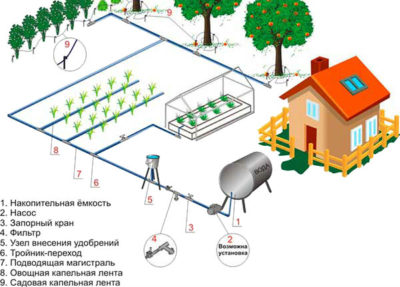
It is necessary to provide a crane for emergency shutdown of water supply.
Arranging the layout of watering at the dacha, it is necessary to determine the mode of its use, since the water supply system can be summer and winter. One way of routing differs from the other by the depth at which it is necessary to lay pipes. For all-season dachas, warm water pipes are usually provided. This system requires the laying of pipes lower than the depth of freezing of the soil.
Winter type of wiring is necessary when there is a greenhouse on the site. In this situation, you need to prepare a good ditch and laying insulated pipes. The most rational is the use of the summer version of water supply.
For the wiring device, you can use the water supply scheme from polypropylene pipes. It is equipped taking into account the possibility of draining the water for the winter period of time. Preliminary it is necessary to calculate the required amount of water consumed, adding to the result obtained just in case a small amount of stock. When calculating, it is necessary to take into account not only the volume of liquid for watering plants on the site, but also the water requirements of the family members of the owner of the dacha.
To install a pump outlet into the house at the dacha with your own hands, you will need polyethylene pipes laid in a trench with a depth of 50-60 cm. The pump is installed in a well or well, from which water must be supplied for consumption. The pump can be controlled from the house using a cable inserted into the house.

How to make a self-made well on the site
When arranging the mine well in the dacha with your own hands, you should not only install a log house of wood, but also take care of the following elements of the water supply system:
- 1 Power.
- 2 Spout with a tap.
- 3 Shut-off valve.
- 4 Pipes.
- 5 Hoses.
- 6 Sand.
- 7 Crushed stone.
- 8 The box.
- 9 Blinds.
- 10 The clay castle.
- 11 Cover.
- 12 Ventilation riser, etc.
Installation of a shaft at the dacha with their own hands is made in the event that water is planned to be used in small volumes. Its design is quite simple. For the normal operation of the device it is necessary that the groundwater lies at a depth of 3-4 to 10-15 m. This depends on the region in which the country house is located.
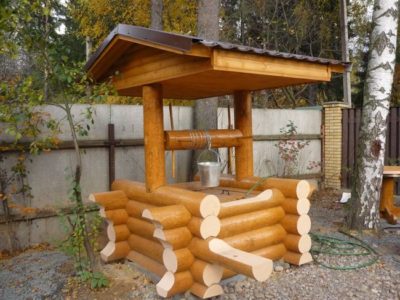
The constituent elements of the well are:
- 1 Ground part (headband).
- 2 Rings of reinforced concrete.

- 1 Simple ("on the sand").
- 2 Artesian wells ("on limestone").
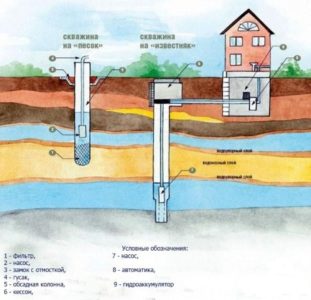
Wells of the first type can be drilled independently for 2-3 days with the help of a drill. You will also need a steel pipe, a pump and a special filter mesh. This type of well will provide a small plot of water for 5 years. The cost of an artesian well is too high, but its service life is more than 70 years. It allows you to supply water in a volume range from 4 to 110 m3 / h. To drill an artesian well, it is necessary to attract specialists and get permission to create such a well from local authorities.
The device of an independent waterpipe
The water distribution in the dacha can be done in various ways, the main ones of which are related to serial connection pipes or with the help of a collector. This device allows you to connect the pipe to each individual point. The collector is a pipe with a diameter larger than that of the hoses. Connecting to the collector of devices that consume water through hoses must be parallel. Due to this, the pressure in the supply pipes is equalized. The flow of water into each of the hoses is uniform, which does not depend on whether neighboring cranes are open or not.
Different types of water pumps can be used for irrigation. These units are light enough, compact. They do not require special maintenance, as they are equipped with a pressure gauge, a hydraulic accumulator and a pressure switch. This allows you to maintain the automatic mode of operation of devices operating on the principle of pumping stations.
The water supply at the dacha can be arranged using a tank that allows not only to have water in reserve if it is turned off, but also to collect rainwater. A high-quality filter system is required to purify water. At the first stage, the rough cleaning, and on the second - thin. The latter is more thorough and requires the use of several filters for safety.
Use the tank in the water system on the site is very effective for plants, because in the summer it will heat up the water if it is installed on the street. Watering plants with warm water allows you to achieve the best fructification of crops. The dacha can be equipped with a system drip irrigation, if you connect special hoses to the tees.
And a little bit about secrets ...
Have you ever experienced unbearable pain in your joints? And you do not hearsay what it is:
- impossibility to move easily and comfortably;
- discomfort when climbing and descending the stairs;
- an unpleasant crunch, a snap not at will;
- pain during or after exercise;
- inflammation in the joints and swelling;
- unreasonable and sometimes unbearable aching joint pain ...
And now answer the question: are you satisfied with this? Is it possible to endure such pain? And how much money have you already "merged" with ineffective treatment? That's right - it's time to finish with this! Do you agree? That's why we decided to publish an exclusive interview with Professor Dikul in which he revealed the secrets of getting rid of joint pains, arthritis and arthrosis.
Many owners of holiday homes, begin to build a summer cottage only after they have carried water to the site. Even with the construction of a frame house in which water seems to be nowhere to be found, concrete and solutions for "gravy", "podmazki", work on the construction of the foundation will always be there, and that means water. In addition, water, as the basis of life, there is always and when you use our 6,000 hectares for their intended purpose. Watering the garden and kitchen garden, washing the car, paving tiles which paved the yard, and of course your own washing. So, the supply of water to the suburban area is a priority issue - that is why in this article we will try to consider the maximum number of issues related to the water supply of the dacha and the plot.
If a central water supply system passes near the site, the solution of the problem is not greatly simplified. Soviet water pipes are dilapidated and almost completely worn out (recently, when replacing the old water pipe, a pig iron pipe was dug from a comrade with a stamp of 57 years - cast iron literally crumbled into pieces). And new water pipes in modern Russia are paved extremely rarely, it is very expensive, and even in order to achieve this, one has to address almost directly to the President (the history with the woman who asked him for help in this matter is probably remembered by everyone).
Therefore, in order not to depend on someone's good will and use the water as needed, the summer house owner has only two options: a well or wells, although, incidentally, many experienced summer residents combine both options - even more substantial savings are obtained.
From the list of solutions to the issue of dacha water supply, we previously excluded the use of natural bodies of water - you know which ecology you know, not only for the kitchen and for irrigation, it is terrible to use, and despite the fact that the Slavs always tried to build dwellings near the water, not all do not care.
Criteria for choosing the type of water supply and water supply
Here, as in the famous proverb - you need to measure all seven times, that is, in advance, calculate how much water you will need for a normal residence in the country of the whole family, and do it even with a small margin.
The calculation should be carried out taking into account all points of water consumption and pumping, taking into account the number of constant use by all family members. Must be taken into account and the most water-consuming objects - sauna, bath, pool in the country, the area allocated for growing vegetables, a fruit garden that in some regions without irrigation is now difficult to grow.
With each liter of water included in the water flow, the prospective future source of water supply should also become more abundant.
When placing the source of water supply, be sure to take into account the fact that every ten meters of the pipeline, reduce the pump head by 1 meter. It is necessary that the water could be delivered to the most remote corners of the site, the garden.
With a small water flow - for example, if you use the house only as a summer home and a place to relax, you can make a mine well. It is simple in construction, relatively inexpensive, and all the work on its design is easy to do by one's own hands. It is supplied by water due to groundwater, the depth of which varies from 4 to 15 meters.
The construction of a mine well is the simplest: above the ground is a headgear, underground reinforced concrete rings or a log house of a wooden beam, usually 25 cm thick.
The mine of such a dacha well should be deepened into an aquifer layer by 3, and even better by four meters. At the bottom of the shaft, alternate soybeans of sand, gravel, crushed stone, each of which should be 20-25 centimeters thick, subsequently they will act as a natural filter for cleaning incoming water. Many in addition to the bottom flow of water also make holes in the concrete rings, so that it comes from the sides. Then a submersible pump is installed on the bottom.
The amount of water that can provide a mine-type well can not be calculated in advance. To do this it will be possible after its construction - for this purpose the initial volume of water flowed into it is calculated, then it is pumped out by the pump and the time through which it is refilled to the previous mirror is measured.
In principle, the normal water supply of the dacha is enough for him always, they dry up too extremely rarely, in my practice of "shabashnik" this happened only a few times, and even after pumping out water and cleaning and disinfecting the well, water began to flow again.
If the groundwater is deep.
If a suitable aquifer is at a depth of more than 15 meters and deeper, then the option with a well is no longer necessary, in this case it is necessary to drill a well. Bury them "on the sand" and "on limestone." We will explain:
Drilling a well into the sand is much faster, much cheaper, and so much easier that if you borrow someone from a tool, then even an inexperienced person can cope with this work.
For the installation of a well on sand, only a pump, a filter grid, and casing steel work, with a diameter of 125-133 mm, will be needed.
Drilling a well "on sand" takes no more than two days. Such a well will provide you with a water volume equal to a cube per hour. This is a bit, but it will be enough for the majority of site owners.
Among the drawbacks of drilling a well "on the sand", it can be noted that the water from it is not very clean, and, consequently, the well will eventually "boil over". As a rule, even at very intensive use, the life of the well "on sand" is 4-5 years.
Artesian well or "limestone" well it costs a lot, it takes a long time, 90% of the summer residents will not be able to drill it on their own ... But it serves for a long time, from 30 to 75 years (depends on the amount and concentration of suspensions), can give "up to 5 to 100 cubes of water per hour" at a depth of 30 meters).
Drilling artesian wells or wells "on limestone"
The most common method is to lay the casing to the limestone layer through the clay layers. The next stage is the "opening" of the limestone layer, which is drilled with the so-called "open trunk", up to the aquifer itself.
In order to avoid damaging the rock through which surface waters can penetrate deep into the earth, a backfill is applied that involves pouring a small volume of cement-sand mortar through a special steel pipe under the limestone layer. There is such a peculiar sealing of cracks through which contaminated surface water could get into the "artesian".
By the way:
This type of wells is even prescribed to receive a special "well passport".
Using the so-called European technology of drilling a well (the so-called because the same technology was used long ago in some regions of the USSR), the well device is of a two-pipe nature. The first pipe with a large diameter becomes limestone itself, after which a well with a final working diameter is drilled. In order to avoid contamination of the artesian well by surface water, a sealing plug made of compactonite clay is made between the two types of pipes used.
Such a well at a cost will be more expensive than an ordinary one-pipe by more than 50%. As a rule, they are drilled by several neighbors in a fold, but even then it turns out all the same is expensive. Their very existence at this cost is explained by the very high quality of water.
The rise of water from a well or well
So, we got to raising water from a well or a well. To adjust the supply of water from a not very deep pit, the vast majority of summer residents use surface pumps. The main condition and application of the distance from the source of water to the house: in most designs of such pumps it can not be more than 50 meters (or rather, it can - there will not be any sense).
If the well is deep, or the filter well is used for obtaining water, the same surface pumps, but already ejector pumps. More often, submersible well pumps are used, which easily "overpower" the distance of 40 meters (depth).
Well, if you are a lucky owner artesian well then we will have to use a submersible borehole pump, which completely popped the rise of water from a depth of 100 meters.
If there is a desire to automate this entire business, then you will have to resort to buying CABs (systems autonomous water supply) which consists directly of the pump itself, the hydraulic accumulator and the control pressure switch. The thing is great but for many, it's expensive.
Pros and cons of different ways of water extraction
1. Mine Well. (Figure 1 in the drawing diagram)
The work is laborious. In spite of the fact that it is possible to do a lot with its own devices, technicians and assistants will have to call at least at the stage of digging, removal of land from the sub-crooked space and dropping it there concrete rings.
The advantages of the shaft well design are obvious: the possibility of independent repair, cleaning and disinfection as the need arises (it may not come for decades, it all depends on the place). It is recommended to resort to the mine structure in cottages and a site with a close groundwater table.
2. What is slaughtered or otherwise abyssinian well. (Figure 2 in the drawing diagram)
This is such a design, in which the earth is clogged with a steel pipe, until it reaches the underground water table. On its lower link there is a filter and a head with holes in it, through which the water itself will fall inside this very steel pipe, and pumped out with a pump.
3. What is well chamber. (Figure 3 in the schematic drawing)
The option that people move to a dacha for permanent residence and young people give their apartment (or rent) is not uncommon now - therefore, water is needed constantly. In this case, a well is built to protect electrical devices from the effects of precipitation. The camera is easy to build with your own hands from the same concrete rings or blocks with maximum waterproofing. A cover is required.
4. What is borehole (Figure 4 in the schematic drawing)
This is a water supply device when the borehole is drilled to a mirror groundwater. Then to a depth of 7-8 meters, it mounts an ordinary sewage pipe (115 millimeters in diameter), after which, with the help of a filter piece (such blue polyethylene pipes), water enters the pipe and is taken up.
Water supply from the well - both cold and hot: how to do?
If the dacha already has a section of a well (maybe dug by one's own hands and maybe left over from the previous owners), then at relatively low cost it is possible to organize not only a cold but also a hot water supply at home. In our case, an inexpensive submersible pump "Aquarius" was used to raise water. The outlet of the pipe from the well is waterproofed with silicone and cement. The distance from the well to the house is 5-6 m. To prevent a stagnation of water in the system, a valve is placed at the lowest level of the network.
We draw water by our own hands - step by step
1. Using a cable, the pump was lowered into the well, preventing the tension of the power cable and the supply hose. We fixed the cable on the surface. On the supply hose was installed a head for water intake.
2. We put water in the house on polyethylene pipe, stretched along the bottom of a trench 50 cm deep. In parallel, a second pipe was laid, inside which an electric cable was passed.
3. The supply pipe was connected to - a further part of the water pipe with a check valve to prevent draining of water back to the well. We installed a mechanical (coarse) filter.
4. Have brought a feeding hose in the house. A pressure switch, a pressure gauge and a fine filter were installed at the inlet distributor unit. Have connected all to a power network.
5. After cleaning and filtration, the water enters the accumulator, which maintains the required pressure in the pressurized water supply system, saving the pump start-up time.
6. From the distribution unit, wiring was carried out on the walls of polypropylene pipes. In the bathroom installed shower, sink and water heater.
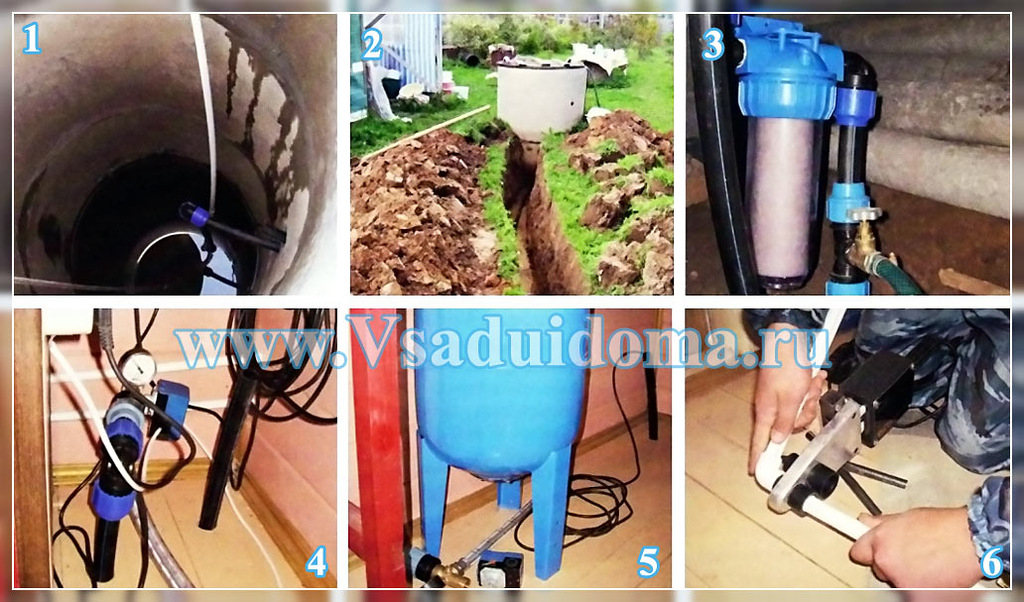
More about the device wells.
Requirements for a "right" well should be known to every summer resident, who was puzzled by the issue of its construction.
Often, in a suburban area, not connected to a centralized water supply, the owners of the dacha have to drill a well or dig a well. The task is not easy. But even in case of a power failure, the well will provide continuous water supply.
With a relatively shallow depth of groundwater in the area (up to 40 m), shafts are constructed, water enters them through the bottom of the well (90%) and partly through loose connections of the walls (10%). The usual depth of such a well is 10-15 meters.
Signs and signs of a near occurrence of groundwater
1. The most reliable sign (unfortunately of course) - the water in the basement, cellar.
2. The proximity of natural reservoirs - lakes, rivers.
3. Dense evening mist in the absence of water.
4. Juicy thick grass even in hot summer, not withering in the heat.
5. Plants on the site that need a lot of moisture.
6. Moss and mosquitoes in the air after sunset
7. Patch on the site and cover the ground in some places with a light layer of moss.
How to start making a well
The best time to dig a well is autumn. In autumn, as a rule, the water table is the lowest. Otherwise, you can "undermine", and the well will come out dry.
If the area is hilly and has elevations and irregularities in the landscape, then the highest place will fit better for a well - it sounds strange, but it's right, and that's why.
According to the laws of gravity, surface waters, which most often pollute the well, will flow in the direction from the well, and not to it, because in the well water will be cleaner. Avoid the banks of rivers and places with a sharp drop in the relief due to possible fluctuations in the water table. The minimum distance from sources of pollution (cesspool, car park, toilet) is 25 m, from the house - 4-5 m - this requirement is compulsory.
Despite technical progress, digging wells is still manual labor. The walls are traditionally strengthened with wood, concrete, stone or brick. The process of penetration is much simpler with the advent of reinforced concrete rings (more often use rings "KC 10-9" or similar to them with a height of 0.9 meters and a diameter of 1 meter).
The initial ring is mounted on the bottom of the prepared pit, the following are added from above one by one as the excavation of the ground from underneath, which gradually settles. In the aquifer, one or two rings are installed. After that, the joints are sealed with a solution, and the bottom is covered with a layer of gravel or gravel 20-30 cm thick - it serves as a filter for incoming water.
The space around the mine is covered with gravel and sand, and since the depth of freezing of the ground, a so-called "lock" of clay is arranged that is necessary to prevent surface and especially meltwater from entering the well.
Umbombovannaya clay - an excellent waterproof, so that additional waterproofing is not needed. On top of the clay make a concrete pavement with a hard surface and a slight slope for drainage. The wellbore of concrete rings is absolutely waterproof for groundwater, therefore, with competent construction, you will always have clean water in the well.
The well itself - drawing 1 and photo
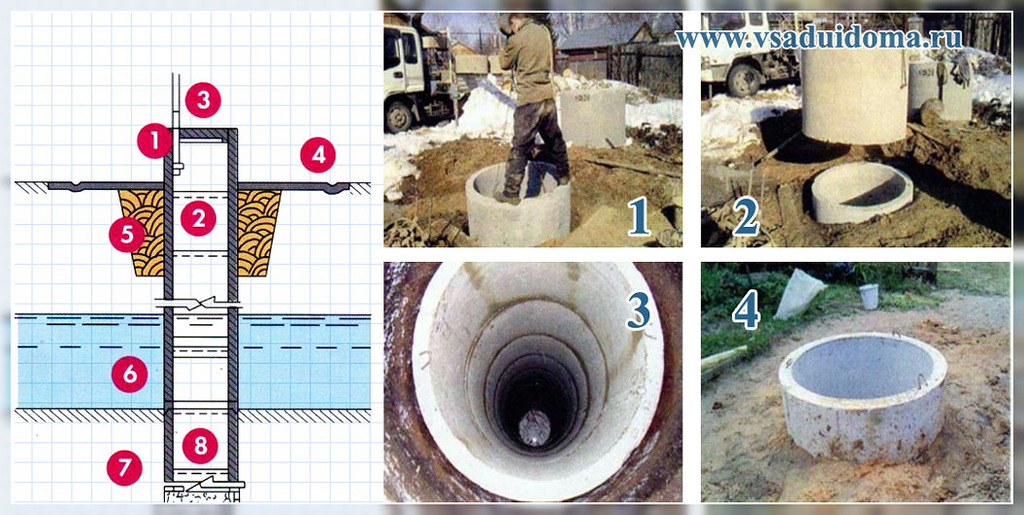
On the diagram-drawing with numbers:
- title
- rings
- ventilation tube
- blind area
- clay lock
- aquifer
- waterproof primer
- reservoir
In the photo (right), the figures in the construction of a well of concrete rings:
- Laying the first ring
- Installation of the second ring
- Sealing joints mortar
- backfilling
Making the head of the well
Once the last ring is installed and the water level in the well is sufficient, we start building the ground part. Original and beautifully designed head ( outside part well) will be a worthy decoration of your site.
The head should protrude above the ground approximately 1 m, and the mine itself should be covered with a lid. Above it, a roof is built in the form of a closed house, a canopy or a gazebo. A well-made roof will protect the well from dust, precipitation, foreign objects and foliage.
To raise water, use gates various designs, manual or mechanical pumps. Cranes - the popular lifting devices in villages - are too cumbersome for small dachas, so they are rarely used here.
Mine well - installation of "log house under the ground"
The installation of an ordinary, shaft well with walls from a beam or logs is done simply by digging up the soil under the frame.
Logs for a log house of a well need to be taken high-quality, a departure from a bath or other remains after construction will not go.
Check the logs for mold, woodchip grinder, fungus, etc. The forest should be taken only dry and no differently - the opinion "will still get wet" is mistaken.
Typically, the thickness of the forest for the installation of well logs in the mine type varies between 20-22 centimeters. I think that the forest intended for these purposes should be cleared of bark and knots superfluous.
The logs of the log house must be assembled on the surface for easy assembly, making the usual cut-off marks. After that, the wreaths are disassembled in strict sequence, so as not to confuse the queue during assembly and lower it into the shaft, where they are tightly fitted in place.
At the next stage, in the middle of each of the 4 sides of the log, a 25-30 centimeter sampling of the earth is made, after which the pores at the corners of the frame are removed in turns. Freed from the corners of the support leads to the places where the soil was selected and fix them there, again in turn. Now dig out the soil at the corners of the log, resulting in the design is lowered, and repeat this work until you reach the groundwater level.
The gap that forms between the walls of the log and the pit (from the outside) is covered with the same soil that was taken out of the pit and as tight as possible. After that you can go down to the well shaft and trim its walls.
What should be the taste of water from a wooden well
The taste of water in wooden wells depends largely on wood. It is better to choose alder, lime or birch: the aftertaste will be almost invisible. True, these breeds are strong. A log house made of unprimed pine will give the water a resinous taste. And the water from the aspen well is slightly bitter at first. Most of all for the construction of wells, larch leaves. She, like the oak, does not attach any "suspicious" smells and serves 20-25 years.
Care of the well
Inspect and, if necessary, clean your well, do it according to the recommendations of the old "well work" of the craftsmen at least twice a year.
Garbage can be removed and bucket, but it is better to prepare in advance a long pole with a hook on one side and a stack like a net from the other.
We think it unnecessary to say that one should not climb alone in a well.
Before you go down into the well, check its gas content.
The general rule of work in the well is to check its gas content, it is recommended to do it always, regardless of whether there is a gas or swamp outlet nearby. The simplest method of candle on the string: it burns smoothly - everything is fine, the flame oscillates and gradually fades away - there is gas, but there is not much of it, and if it goes out, then a lot of gas can not be descended.
If the well is old ...
In practice, if you bought a site with a well in the secondary market, you can not use a well - it must be cleaned, it is not enough that old owners were dropped there (well, if not specifically, people are different, even more so in our time).
The old well should be properly cleaned by pumping water out of it. Pump out water gradually: after lowering the water level by 30 centimeters - half a meter, clean the walls, then pour out the same volume of water again and continue cleaning, and repeat until you reach the bottom, which must be cleaned especially carefully.
After cleaning, the well and the outer house are disinfected with 10-15% bleach solution: the walls are impregnated with it 2-3 times. Then the remnants of the solution are poured into the well, mixed with water and in this state for 24-48 hours. At the same time, the head of the well is carefully covered with a tarpaulin so that the chlorine does not evaporate. The first water, which after cleaning is filled with a well, you need to pump everything out.
On a note:
When digging a well, the approach of the aquifer is determined by a noticeable cooling: the air temperature in the well drops by a couple of degrees, and mini-fontanels appear on the walls of the mine.
The well is a sacred place for almost all peoples. On the eve of the great church holidays (Easter, Christmas, Epiphany), the water in the well was considered miraculous. She was washed, consecrated buildings, kneaded bread on her. Water from a new well washed children so that they did not cry.
The well requires a serious approach. In the village, the "well" traditions are observed before the pores: do not arrange gatherings and picnics around the well, do not smoke and do not swear near it, do not give water from your well to ill-wishers and strangers, treat the well with reverence.
Pumps for a summer residence - how to choose correctly, what they generally happen
Of course, the type of pump for water supply of the country house and the site will depend on the type of water source and its parameters in the form of the number of water outlets and such characteristics as diameter, total water volume, and, of course, depth. The level of concentration in suspended water is also a very important characteristic.
The actual choice is based on the above three types: a well pump, a pump for a well or an automatic water supply station.
The simplest and cheapest solution - submersible pump for well (Of course, if you chose a water well of one of the above types for water supply of a dacha).
Such a pump will easily provide precious moisture to a small country house, and of course watering.
Its design is simple: stainless materials, engine, start relay, centrifugal pump.
Mounting itself is not required for it - tie it to the string more tightly and lower it into the well, not reaching the bottom of 1 meter.
A submersible well pump can pump up to 6 cubes per hour from a depth of 10 meters (manufacturers' assurances about 30 meters or more do not even pay attention, the sellers themselves in stores are angry because pumps are often returned with scandals back, they just do not pull such depths ).
Some brands produce submersible pumps with a base - they can be put on a clean bottom of the tank.
Also from the advantages of submersible pumps can be called the fact that to the quality of water they are practically insensitive, at the entrance they are equipped with a filter. In favor of these words says that the masters of "wells" for many years digging wells carry the same pump with them to pump the first muddy water from the customer's well, and only then I connect the master pump when the water is coming already clean.
Cooling at submersible pumps is natural, due to the pumping through itself of cold transported water.
This type of pump is low-noise, does not require prevention (works on the principle: it broke - it's cheaper to buy a new one).
Of the minuses relatively (in comparison with well pumps) large dimensions. The electricity consumption, and the lack of automation - will pump until you turn it off.
Downhole pumps (deep pumps)
Actually in the title everything is said - are needed for lifting and supplying water from wells, from great depths up to 40 meters inclusive.
Choose precisely knowing the depth of the well, and calculating at least approximately its need for water. The passport of the well with the characteristic of the number of liters of water per hour to help you and, of course, the advice of someone who drilled a well (if they did not drill with their own hands).
The borehole pump is not bought with a reserve - if the water is pumped out earlier it will work idle, and this is for downhole pumps an unacceptable load and a time that predetermines the life expectancy of their work.
The dimensions are very compact, enabling them to extract water from even very narrow wells. Water pressure is excellent - without going away you can water one third of our standard plots in 6 hectare.
Additionally.
The most ideal variant of water supply with the use of pumps is, of course, automatic, arranged with a pump, a hydraulic accumulator, a pressure gauge, a pressure sensor relay, shut-off and check valves. With this design, water is enough for everything and for the washing and dishwasher and for car washing and for watering and showering.
Home station
A pumping station that operates in automatic mode is the best solution for autonomous water supply to a dacha. It replaces the submersible pump and delivers water from the water storage tanks at 10 meters. In it there is already mentioned accumulator, relay, grid filters, etc.
The rod of the system is a pump, it can be either centrifugal or vortex.
Vortex will provide smaller dimensions than centrifugal, it is cheaper and pressure gives greater. The main disadvantage of a vortex pump is that it does not tolerate even the slightest contamination of water and quickly breaks down.
ANS with centrifugal pump to the quality of water is "indifferent" - it swings what it is, it can be equipped with an ejector, which further enhances its power and will allow water to be pumped from 20-25, and in some cases more than meters.
Of the minuses - very noisy.
Other options for a separate, autonomous water supply are also many, given the annual improvement of manufacturers in this area. Every year, water filtration methods are improved, the productivity of pumps increases, and therefore it is always possible to increase the depth of the future well to improve the amount of water.
How to calculate the amount of water you need.
Daily and weekly water costs can be determined by knowing the flow at all points of the intake. In this you will be helped by the water flow rates stipulated for various sanitary devices and devices.
On a note:
Watering the lawn will require at least three cubes of water per square meter. The water flow can thus both increase and decrease due to the method of irrigation - fan, drip, automatic irrigation by the time of day.
Watering lawns and flower gardens requires 3-6 cubic meters of water per square meter, the flow rate also depends on the method of irrigation and the intensity of irrigation.
Calculation of water pressure - formula
To calculate the pump head you need, use the formula below:
"Нтр = Нрео + S + Нсвоб".
Ngeo - the height of the pipeline entry into the building relative to the water level in the well (which is necessarily indicated in the well data sheet).
S - the sum of all head losses due to friction in the water pipe and other parts of the system.
Nswob - the pressure that is necessary at the point of entry into the house, taking into account the provision of pressure at the highest and most remote point of water flow (0.5 atmospheres).
Interesting fact:
Water-lifting devices, consisting of a wheel and attached trays and jugs, were known in ancient times to many peoples. The wheel revolved by the power of the river, scooped up by jugs the water along the trays moved by gravity for long distances. Later the most simple pumps, made of wood with a movable piston to draw water from the well. In the first century BC, the Greek scientist constructively described the first pump for extinguishing fires.
- Be sure to compare those parameters, and the water quality characteristics with those recommended by the pump manufacturer in the REM.
- Make sure that the pump is equipped with protection against voltage surges, "idle", sealed, resistant to water hammers.
- Be sure to read the instructions for installing the pump and installing it - even if you do not install it yourself, you will monitor the situation when installers install it.
- The guarantee for the pump and the service of things for them is far from idle and must necessarily be - pumps work under heavy load and failure of them is not such a big rarity.
- I do not advise you to take pumps with a plastic casing, in general, when buying a case for quality, pay close attention.
Principle of operation drain pump
On the leading shaft of the drainage pump is fixed the impeller with the blades. Through the suction grate at the bottom of the pump, pumped water enters the rotating blade channel. Here, dragged by the impeller into rotation, it acquires a significant speed and radial (from the center to the periphery) pressure. At the outlet of the impeller, the liquid leaves the pump through the branch pipe with an intensive flow.
Float switch
This device, which is used as a level sensor for pumping water to control the operation of the pump. The use of a float switch prevents the pump from running without water (protection against "dry" running), thereby protecting it from damage.
The float is built-in circuit breaker, which (when the pumped water falls below a certain level and the float is lowered) opens the contacts in the power circuit of the pump motor, thereby interrupting its operation. When the water level rises, the float rises and when the level reaches a certain level, the engine power circuit is closed and the pump operation resumes.
Decorate the well - a decorative wooden head with your own hands
Shaft wells, collected from gray concrete rings, naturally do not improve the type of the country plot. Therefore, how to improve this business with your own hands will have to. To hire a carpenter or carpenter because of such a trifle reluctance - because the process is creative, and want to fulfill the idea on their own.
And in the case of a decorative well (such often can be seen on country houses in rural style or "country style") it's even easier - excavation will not be required at all, since the well is installed directly on the ground. The anchor bolts in the ground prevent the structure from tipping over in a strong wind. The role of the well is played by a conventional barrel for irrigation. Water is fed into the container by means of a hose laid in one of the racks and a pump. The bucket on the chain plays a decorative role. There is no need to scoop the water from above, bending under the weight of the bucket: the problem is solved by an additionally installed drain cock at the bottom of the well. It is enough to substitute the container and turn the handle!
Stage one: preparation of wood blanks
1. The horizontal projection of the octagonal well is drawn on the sheet of the paper on a scale of 1: 1.
2. From a bar section 38 x 68 mm, write lengths of 35.5 cm on the outside. Saw the ends at an angle of 45 °.
3. Place the test pieces directly on the plan. If the dimensions are correct, you can start the sawing. In total, you need 88 parts.
4. For threaded rods on which the logs are assembled, drill the segments from one end through and through.
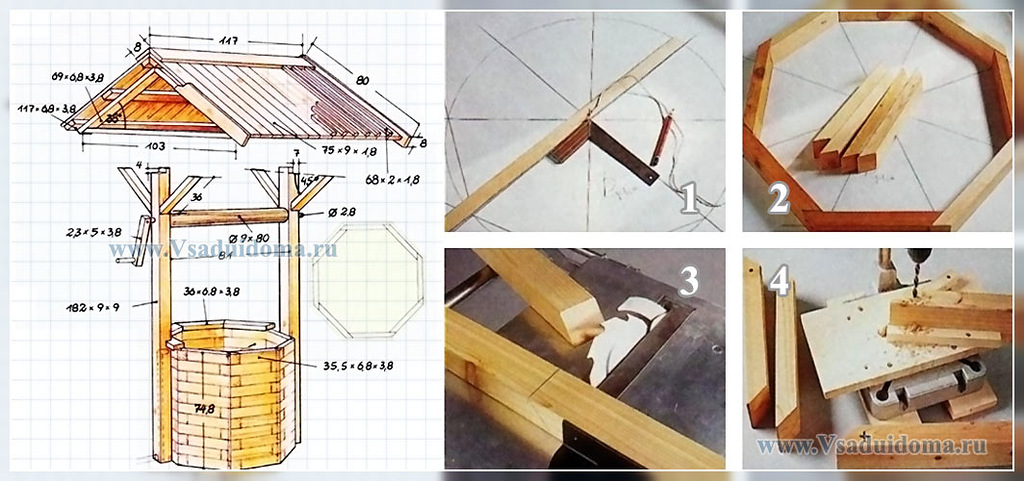
Step 2: Assembling the Well
1. Put the bars of the first row on the nuts provided with nuts and washers. Place joints (ends), glue with glue and additionally fix the screws.
2. Lay the row by row, in each successive row, moving the bars against the rod. Between the rows also use an additional adhesive bond.
3. Lay the last row, thread the threaded rods and flush them with a file. Washers and nuts "drown", preliminarily poking holes.
4. In a segment of the upper row, pre-drill a hole d = 26 mm to install a hose that feeds water into the barrel.
5. One of the racks will hide the water supply. Make a groove in the hose: perform two parallel nagings with a circular saw, then remove the wood with a chisel.
6. Connect the racks to the body of the well with four mounting bolts (8 x 140 mm). Drill holes d = 8.5 mm in advance, insert the nuts inside.
7. After securing the posts, install the water supply. Since the water pressure will be small, simple plastic threaded connections for hoses are sufficient.
8. The parapet of the well consists of blocks laid horizontally and beveled at the ends by 22.5 °. In two segments, first make a felling for the racks.
9. The rods alternately pass through one of the elements of each second row. The details are staggered.
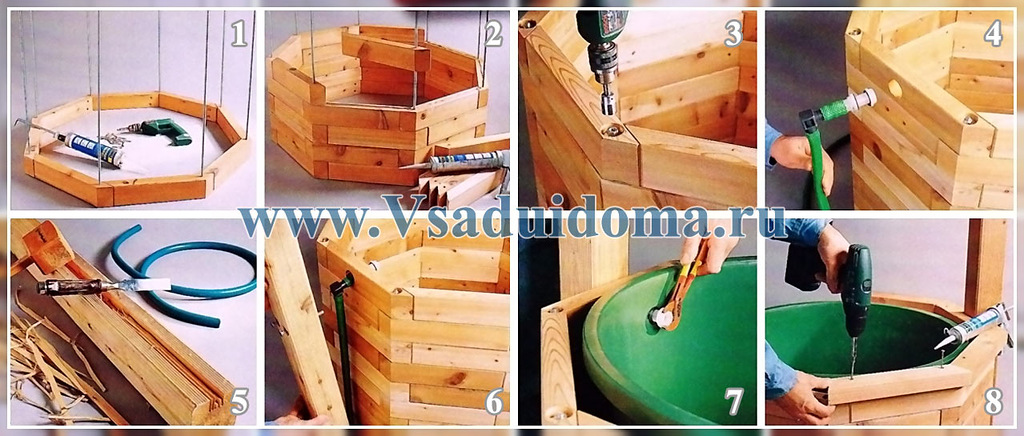
Stage 3: Roof installation
1. The bearing structure of the roof consists of two triangular "pediments", screwed from the bars. For added strength, add an adhesive bond.
2. Fronts connect six bars - they serve as a crate for the roof. The horse consists of two angled and glued bars.
3. Lay a roof over the roof - a simple or sheeted board. Above you can lay the existing roofing material.
4. To ensure that the roof structure reliably rests on the racks, the corners on both sides should be stiffened with the braces. To do this, cut the bars by 45 ° and screw.
5. The axis of the gate is made from a thin log d = 9 cm. For the root necks use round rods d = 2.8 cm. For a crank, take a bar 23 cm long and drill it (hole diameter 2.8 cm).
6. Install the root collars with waterproof glue in the drilled holes. On the side of the handle, release the neck by about 5 cm from the stand. Put the crank on this outlet, after having greased it with glue. When the glue dries, fasten the joint with a dowel.
7. Strengthen the pediment boards, from the side of the ridge, cutting them with the bevel. A small ledge of planks towards the roof is designed to hide the edge of the roofing material.
8. If the well is "not real" but only masks the water column, then the gate design looks like a real one, but plays a purely decorative role: the cervical collars passed through the posts are glued into them tightly and can not rotate.
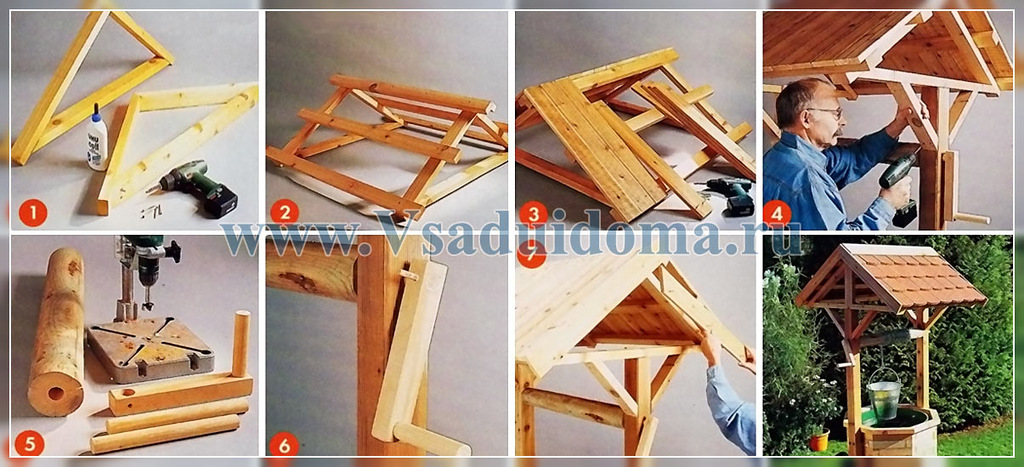
Summer water in the dacha with their own hands
Water supply in the country, where they live in the summer, and the rest of the time come for the weekend (or less), is different from the water supply of the cottage. Firstly, in a house where you stay constantly and year-round, there is always a plus temperature, which can not be said about cottages. Secondly, when constructing a water pipe outside the city, it is necessary to provide for the supply of water not only to the house, but also to a bathhouse, a summer kitchen, a greenhouse. Thirdly, the summer water pipeline is used mainly in the summer, and in winter it is not operated. Depending on your needs and frequency of visiting the dacha, a fixed or collapsible water system is chosen. The second option is as simple as possible in the device and is a simple hose lying flat on the ground. In the autumn they are taken for storage in a barn.
Choosing pipes
For the stationary scheme of the summer water pipe, the pipes are laid in the ground, and only the water taps are withdrawn to the surface. The choice of pipes goes between two types - polyethylene (HDPE) and polypropylene (PP). Pipes HDPE are cheaper, but it is unlikely to save much money, as the components to them will not be cheap. Polypropylene pipes are more expensive, but they have a lower cost of related materials. However, for installation of polypropylene pipes a special soldering iron is required.
How to avoid water freezing
Both polyethylene and polypropylene pipes are resistant to freezing. For possible winter use of the water pipe they are put into the ground to a depth of 1.5 meters (below the freezing level of the ground in middle lane). If you plan to use water only in the summer, one meter of depth is enough. Digging a trench only makes sense to a residential building - you can plant pipes along the surface of the garden and vegetable garden.
The thermal insulation system will save the water supply during winter use, if you do not want to deepen it. Special heat insulation of pipes and polyethylene corrugated casing will allow to lay pipes to a depth of up to 30 cm. Another option is laying the heating cable, which will make it possible to place pipes directly on the surface.
Optimum diameter of the pipes: the house usually has 15 mm, for piping use pipes with an inner diameter of 20 mm or 25 mm, the inlet pipe must be at least 32 mm.
Calculation
Before buying any necessary parts, study the place where the water comes from (the diameter of the valve, if it is already there, must match the diameter of the pipes). Next, determine where the conclusions will be - for example, in the greenhouse, near the car site, etc. Then draw a diagram on the site plan - how you will hold the pipes from the outlet point of the water. The plan will allow you to more accurately calculate the number of necessary parts and help explain with the seller.
Tips for organizing a plum
- When connecting the water heater, provide a tee and a tap for discharging used water with a hose attachment
- To drain more than 50 liters of water, consider a branch that will not go to the septic tank or the los, otherwise you will have to dump water into the street which is not only not aesthetically pleasing but also inconvenient.
- Traditional ceramic mixers or taps with a rubber seal are less sensitive to freezing of residual water.
On a note:
The main disadvantages permanent water supply, which is used only in the summer is the correct slope of all the pipes of the system, namely all of them must go with a slope to the place of the tie-in connection.
As a rule, the tie-in is the lowest point of a water pipe, usually here a valve is made, which is designed to drain water for the winter or in case of repair of the water main.
The summer water supply does not need to be autonomous (from a well or a well) - it can be connected to the main water pipe (if it is). In this case there is no need to drill a well or dig a well, energy is saved, but a monthly payment for the use of water appears.
Preservation of aqueduct for the winter
If the dacha is not drowned in winter, then drain the water from the system will each time before a long departure, absence.
Drain will be more convenient if before check valve pipe through which the house receives water to establish wiring, tee and a tap for emergency draining.
The same tap will also be needed at the lowest point of each branch pipe in the house. Do not forget to remove water from washing machines, toilets, etc. devices. A simple discharge of water in these cases is indispensable - the units must be turned over or blown by a compressor. Water from the toilet should be pumped out (or covered with salt) so that it does not freeze in winter and does not rupture the toilet bowl. The sequence of actions is as follows: first, the pipeline leading to it is released from the water, then the liquid is taken out of the water heater, washing machine and plumbing. After draining, the residual water in the expansion a membrane tank Do not damage it when it freezes.
Plumbing from polypropylene
First, collect all the screwed connections, then they are attached to the pipe. The most difficult thing is to assemble the connections to the threads so that no water leaks out of them. AT threaded connection on one part external thread, on the other - internal. On the external thread, neatly wound fum-tape (enough for 6-7 layers, but if the thread is completely bad, then you can and more).
Then twist and tighten the parts tightly pressing them to each other, taking care not to admit a skew. After that, you can gently pull up the details with the key, without fanaticism, of course.
To fix the pipe in the coupling, it is cut smoothly with a hacksaw.
Having loosened the clamping nut as much as possible, insert the pipe tightly. The pipe, which has entered the coupling as far as the stop, continues to push further - another centimeter to two. When the pipe finally stops - tighten the clamping nut.
Assembly of the summer water supply system at the dacha with their own hands - description for the photo
1. We measure and cut the pipes, clean the burrs of their burrs, take the welding machine.
2. Welding of polypropylene pipes. The technology is simple: the element of the apparatus is heated to the melting point of the pipe, one sleeve is put on the sleeve, and the pipe is inserted into the other. The pipe and coupling are melted, they are removed from the apparatus and inserted into each other. Frozen, they form a single whole.
3. We establish a tee - the branching of water into the house and to the garden. Let's make a conclusion on the crane. If in the future such a water pipe is planned to be finished and for example to increase - put a plug.
4. Push the nut of the coupling onto the tape, turn it on plastic pipe with a crane. It is very convenient to use it to preserve the water supply for the winter.
5. Putting water into the house. The hole for water injection was done more than 2 years ago, when they put the kitchen and the sink. The drain went then into the pit.
6. Ready water supply in the house with flow filter. In total, you need at least two filters - a standard mesh and flow-through with one tank.
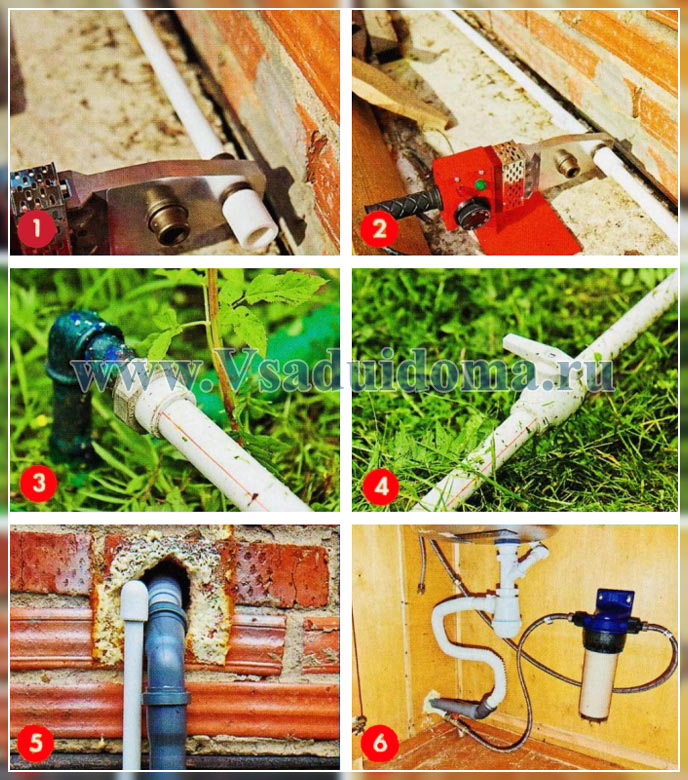
Analysis of water, its purification and filtration
In the city for quality drinking water follow the sanitary services. Outside the city, all responsibility falls on the owners of summer cottages. How do you know if water is suitable for consumption or is it full of harmful substances that adversely affect your health? The laboratory analysis of the water will give a detailed answer to what exactly we will drink under the guise of a transparent liquid. The sampling of water for research will be done either by a specialist or by yourself.
The most polluting waters are drains from poorly isolated cesspools. From there we get bacteria and viruses, eggs worm. Household sewage will give water surfactants, salts, complex aromatic hydrocarbons, phosphates, nitrates and nitrites. Mineral and organic fertilizers will add calcium, carbonates, sulfates, chlorides. And after washing your own car on the site you will receive oil products, particles of lead, cadmium and other heavy metals (they contain in excess soil along the highways). And if the car we can wash on the car wash, then what about the water after washing the laundry and other inevitable drains? The solution is to install an accessible filtration system and reliable treatment facilities. By the way, when ordering filtration or sewerage systems, the company, where you go, will certainly offer you to do a water analysis for free.
Where to do it?
Laboratory research with quantitative indicators of harmful substances is carried out at the sanitary-epidemiological station, in scientific organizations or specialized laboratories. The protocol with the results and the conclusion about the suitability of water will be given to you in 1 -2 days. Full analysis is best done with a primary source survey, and in the future conduct an annual preventive examination.
What are the water tests
- basic (general assessment of the state of water for 7-16 main indicators)
- complete (about 40 indicators)
- specific (for individual indicators at the request of the customer)
How to send water for analysis
1. Sterile packaging for bacteriological analysis (we get it from the pharmacy or we sterilize it ourselves with steam).
2. The sample is selected "under the neck", so that water does not contact the strongest natural oxidizer - oxygen.
3. For chemical analysis, water can be brought in a clean plastic bottle from under mineral water, rinsed with the previously studied sample.
4. Before removing water from the well, pump the system for at least 10 minutes.
Column for the site
Inside the light structure of the garden, the decorative water column, between the two wooden racks, the galvanized pipe and the fitting with thread are hidden, only the drain cock on the front side remained visible. In fact, the column is a holder for a pipe, the water into which is supplied in any accessible way: from a well or from a central water pipe. The panel on the back side is easily unscrewed and removed, so the supply "pipeline" is always available for repair.
The only difficulty - the construction will require a concrete foundation depth of about 80 cm! The very same column is collected elementary. Two racks of 7x7 cm section are fixed to the foundation by steel anchors at a distance of 7 cm from each other, (special grooves in the anchors - bends of the holders on both sides - provide a sufficient distance between the ground and the tree). Communications are laid between the posts and closed on both sides with wooden panels. It remains to cover the "column" with a lid, which protects from precipitation, and it's ready, such is Russian!
Materials
As a material for the wooden column used wooden bars section 7 x 7 cm and a panel width of 22 cm and a thickness of 20 mm of impregnated pine under pressure. For such a material, a protective coating is not required in principle, but one must be prepared for the fact that in a few years the tree will turn gray.













